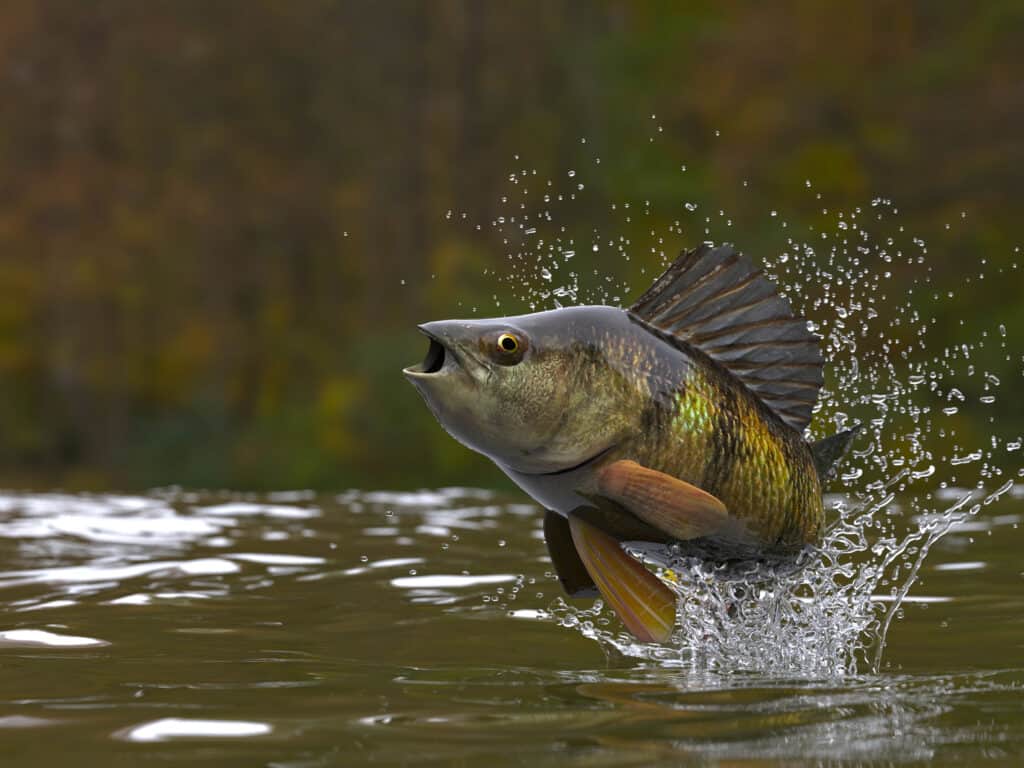Perch Fish
Perca fluviatilis
Some of the most delicious gamefish in the world
Advertisement
Perch Fish Scientific Classification
- Kingdom
- Animalia
- Phylum
- Chordata
- Class
- Actinopterygii
- Order
- Perciformes
- Family
- Percidae
- Genus
- Perca
- Scientific Name
- Perca fluviatilis
Read our Complete Guide to Classification of Animals.
Perch Fish Conservation Status
Perch Fish Facts
- Prey
- Zooplankton, crustaceans, insects, and fish
- Name Of Young
- Larva
- Group Behavior
- Solitary
- School
- Fun Fact
- Some of the most delicious gamefish in the world
- Estimated Population Size
- Tens of millions
- Biggest Threat
- Predators
- Most Distinctive Feature
- Long, round bodies and rough scales
- Average Spawn Size
- 20,000
- Habitat
- Freshwater rivers, lakes, and streams
- Predators
- Birds, fish, otters
- Diet
- Omnivore
- Lifestyle
- Diurnal
- Favorite Food
- Insects
- Number Of Species
- 3
- Location
- Europe, Asian, Australia, North America
Perch Fish Physical Characteristics
- Color
- Yellow
- Red
- Black
- White
- Green
- Skin Type
- Scales
- Lifespan
- 5-11 years
- Weight
- 1-8 pounds
- Length
- 10-24 inches
- Age of Sexual Maturity
- 1-4 years
- Venomous
- No
- Aggression
- Medium
View all of the Perch Fish images!
Summary
Perch are considered by many anglers to be some of the best freshwater gamefish in the world. Worldwide several hundred species go by the name, but only 3 belong within the perch genus. They belong to the order Perciformes, or ray-finned fish, to which they also lend their name. They are powerful swimmers, and several species are known to put up a fight.
5 Perch Fish Facts
- They are closely related to well-known species, including walleye, ruffe, sauger, and darters.
- The largest yellow perch ever caught weighed 4 pounds, 3 ounces, while the largest European perch measured 8 pounds, 4 ounces.
- This fish has a sweet, delicate taste that makes it prized by anglers in several regions.
- Females can lay anywhere from 2,000 to 200,000 eggs in a single year.
- The European species is the national fish of Finland.
Perch Fish Classification and Scientific Name
All perch belong to the ray-finned fish order Perciformes, which contains 41% of all bony-fish species worldwide. The order takes its name from the Greek word perke, meaning “perch,” and the Latin word forma, meaning “shape.” Hence, all fish in the order of Perciformes are “perch-like.” However, only the 200 species and 11 genera within the family Percidae belong to the category of “true perch.” Additionally, within this family, researchers distinguish the 3 species in the genus Perca as the model of this fish. These 3 species include the European perch or common perch (Perca fluviatilis), the yellow perch or American perch (Perca flavescens), and the Balkhash perch (Perca schrenkii). The European’s scientific name derives from the Latin word fluvius, meaning “river,” while the yellow perch’s scientific name comes from the Latin word flavescens for “yellow-colored” or “becoming gold.”
Perch Fish Appearance

Depending on the species, perch can put up a considerable fight when caught on a line, particularly the larger specimens.
©bekirevren/Shutterstock.com
Generally speaking, this fish all tend to look fairly similar, although a few variations in size and color exist. True perch are ray-finned fish with long, round bodies and rough scales. They have paired pectoral and pelvic fins as well as two dorsal fins. The dorsal fins can either grow separately or joined, depending on the species. The first fin is spiny, while the second one is quite soft.
European species appear greenish aside from their red pelvic, caudal, and anal fins. These red fins are why some people refer to it as the redfin perch. It also sports eight dark vertical lines on its sides and a large hump between its head and dorsal fin. Meanwhile, the yellow perch appears primarily gold or yellow colored, as its name suggests. Like its European relative, it also sports dark vertical stripes on its sides. Finally, the Balkhash perch closely resembles the European and yellow versions, except that it appears longer and thinner and the dark vertical bars of its relatives.
The European measures the largest among the 3 species, with an average weight between 1.5 and 3 pounds and a length of around 10 inches. That said, the longest specimen ever caught measured 24 inches long, while the heaviest weighed 8 pounds, 4 ounces. Next up is the yellow perch, which averages between 4 and 11 inches and around 1 pound. However, some monstrous yellow perch can reach 20 inches long and weigh over 4 pounds. As for the Balkhash perch, the largest specimens reach up to 20 inches and just over 3 pounds.
Perch Fish Behavior
As juveniles, they usually swim together in schools that can contain anywhere from a few dozen to a few hundred fish. However, as they mature, they tend to grow more independent. As a result, the most sought-after typically live alone except when mating. Depending on the species, perch can put up a considerable fight when caught on a line, particularly the larger specimens. They prefer cooler, deeper water, but move to warmer, shallower water to feed or spawn.
Perch Fish Distribution, Population, and Habitat
You can find them all over the world wherever freshwater is located. As its name implies, the European perch is native to Europe as well as parts of northern Asia. However, anglers have also introduced it to parts of Australia, South Africa, and New Zealand. Meanwhile, yellow perch are distributed throughout much of the United States and Canada and are particularly abundant in the Great Lakes. The Balkhash perch lives in a much more confined range compared to its relatives. It is endemic only to the Lake Balkhash and Lake Alakol watershed, which resides predominantly in Kazakhstan.
You can find them in various freshwater habitats, including rivers, lakes, streams, and ponds. While most species prefer slower-moving rivers, some will spend time in fast-moving waters. In addition, they tend to avoid especially cold or deep water where the light cannot penetrate. This fish are predominantly found in bodies of water that contain plenty of vegetation and debris where they can find food and hide from predators.
Perch Fish Predators and Prey
Several species prey on them, including other fish such as pike, trout, and bass. Some common predators of perch include birds of prey like ospreys, cormorants, kingfishers, eagles, herons, and pelicans. Other predators include marine mammals such as otters.
They are primarily carnivorous, although their dietary habits change as they mature. Therefore, it’s more accurate to classify this fish as omnivores rather than carnivores. Young ones tend to feed mostly on zooplankton and small insects such as mosquitos and midges. By the time they reach adulthood, their diet expands to include small crustaceans such as shrimp and crayfish, as well as other fish. Some fish that they commonly prey on include roaches, minnows, and sticklebacks. Occasionally, perch will also cannibalize their own. Although juveniles are predominantly carnivorous, adults often eat algae and other freshwater vegetation.
While not nocturnal, most perch tend to feed around dawn or dusk. They prefer to actively hunt their prey, which is why many anglers use live bait. They rely on their keen eyesight to help them spot their prey.
Perch Fish Reproduction and Life Cycle
Males sexually mature between 1 and 2 years old, while females sexually mature at around 3 to 4 years old. Perch spawn in the spring and deposit their eggs on aquatic plants. Some evidence also suggests that their eggs can stick to the legs of birds, which may contribute to their transfer to new regions. During a single year, a female can lay anywhere from 2,000 to 200,000 eggs, with larger females laying more eggs than smaller ones. In the wild, most tend to live between 5 and 8 years, while some can live up to 10 or 11 years.
Perch Fish in Fishing and Cooking
Every year, commercial fisheries and sport anglers catch millions of perch. While some species can put up quite a fight, they are still classified as relatively easy to catch with both live and artificial bait. They tend to swim in schools, so where there’s one, you’re likely to find more. Many anglers choose to use live bait and fish at dawn or dusk when perch are most active. In addition to using slip floats, swim baits, and lures and jigs, some fishers also catch them via spearfishing.
This fish has delicate, almost translucent flesh. While it possesses a crumbly texture, it holds up well when cooked. It doesn’t smell particularly fishy and, when cooked, tastes mildly sweet. You can prepare it in several ways, including steamed, roasted, braised, or fried. While you can eat it raw, you’ll want to prepare your perch properly if you intend to eat it without cooking it first.
Perch Fish Population
Perch are some of the most plentiful freshwater gamefish in the world. They enjoy a relatively long lifespan, reach sexual maturity at a young age, and reproduce prolifically. In addition, their popularity as gamefish ensures that perch are relatively protected from overfishing. Despite the fact that fishers harvest thousands of tons of them every year, most populations are stable. Given this fact, the total perch population likely measures in the hundreds of millions or billions. That said, the Balkhash perch has suffered population declines in recent years, likely due to the introduction of rival predatory fish such as the bream and Volga pikeperch. Still, the IUCN lists all three species of true perch as species of Least Concern.
Related Animals
View all 192 animals that start with PPerch Fish FAQs (Frequently Asked Questions)
Are perch carnivores, herbivores, or omnivores?
Perch are carnivores that prey on other marine life. Their diet consists primarily of smaller fish, zooplankton, shellfish, worms, and insects.
What does perch fish taste like?
Perch is well-known for its sweet, well-rounded taste. It doesn’t taste overly fishy, and people describe its flavors as light and delicate.
How much does perch cost?
Perch price varies by location, time of year, and broader economic conditions. In some regions where perch are plentiful, prices for perch can reach as low as $2 or $3 per pound. Meanwhile, perch can fetch up to $20 per pound in some areas.
Is perch a freshwater or saltwater fish?
Although some saltwater fish share the name perch, all true perch are freshwater fish.
Where are perch found?
You can find perch in freshwater habitats throughout Europe, North America, Australia, New Zealand, South Africa, and parts of Asia.
Thank you for reading! Have some feedback for us? Contact the AZ Animals editorial team.
Sources
- , Available here: https://wdfw.wa.gov/species-habitats/species/perca-flavescens
- , Available here: https://nas.er.usgs.gov/queries/greatlakes/FactSheet.aspx?Species_ID=3636&Potential=Y&Type=2
- , Available here: https://www.fishbase.de/summary/359
- , Available here: https://www.fws.gov/species/yellow-perch-perca-flavescens
- , Available here: https://www.sciencedirect.com/science/article/abs/pii/S0044848621009285

















